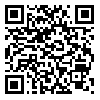Volume 24, Issue 75 (12-2024)
jgs 2024, 24(75): 442-460 |
Back to browse issues page
Download citation:
BibTeX | RIS | EndNote | Medlars | ProCite | Reference Manager | RefWorks
Send citation to:



BibTeX | RIS | EndNote | Medlars | ProCite | Reference Manager | RefWorks
Send citation to:
Heydari M R, Sadeghi M, Rashidpoor A. (2024). Providing a model of religious tourism based on the art of ta'ziyeh (case study: Kashan city). jgs. 24(75), 442-460. doi:10.61186/jgs.24.75.19
URL: http://jgs.khu.ac.ir/article-1-4066-en.html
URL: http://jgs.khu.ac.ir/article-1-4066-en.html
1- islamic azad university, khorasgan, esfahan, iran
2- islamic azad university, khorasgan, esfahan, iran, islamic azad university, khorasgan, esfahan, iran ,Mehr.sadeghi@khusf.ac.ir
2- islamic azad university, khorasgan, esfahan, iran, islamic azad university, khorasgan, esfahan, iran ,
Abstract: (7088 Views)
The purpose of this study is to present a model of religious tourism based on the art of taziyeh in Kashan based on structural equation modeling, based on a mixed exploratory approach. In the qualitative part, the phenomenological method was used and in the quantitative part, the descriptive method, correlation based on structural equations was used. The statistical population of this research in the qualitative part included professors and experts in tourism and condolence in Kashan, which was obtained after 15 saturated interviews. In order to evaluate the validity of qualitative data, structural, external, descriptive and interpretive validity were used and in order to evaluate the reliability, the three approaches of Rao and Perry (2003) were used. The results of qualitative research were extracted from 11 economic, strategic, development, research, organizational, technical, content, environmental and advertising dimensions. After examining the extraction of components, the quantitative part of the research was examined. Factor and content validity were used to evaluate the validity. The reliability of the questionnaire was used from Cronbach's alpha, which had the necessary reliability. Available was selected. The data obtained from the questionnaires were analyzed at two levels of descriptive and inferential statistics, including structural equations, through SPSS 22, LISREL 18.9 and Warp PLS 5 software. Findings showed that the most impact was economic dimension (impact factor 0.86) followed by cultural dimension with (0.79) and strategic dimension with (0.78).
Type of Study: Research |
Subject:
Political geography
References
1. امیری علی؛ مسعودی راد ماندانا؛ بخشی زاده سمیه؛ زارعی زردسواری حسین. (۱۴۰۱). ارزیابی نقش شاخصهای فرهنگی - مذهبی در توسعه گردشگری با تاکید بر آئین چهل منبر شهرستان خرمآباد. تحقیقات کاربردی علوم جغرافیایی، 22(65) :۳۴۴-325.
2. میر کتولی جعفر؛ مهدیان بهنمیری معصومه؛ مهدی علی؛ میرزایی کوتنایی زهرا. (۱۳۹۴). تحلیلی بر آیین های فرهنگی- مذهبیِ بومی و نقش آن در توسعه گردشگری؛ آیین عید مرده ها در شهرستان سوادکوه. تحقیقات کاربردی علوم جغرافیایی، 15(38) :۹۶-۷۱.
3. احمدی محمدعلی؛ سبزآبادی احمد. (1390). تحلیلی بر ظرفیت های توسعه گردشگری مذهبی شهر قم. مجله مطالعات علمی،46:83-112.
4. ابراهیم زاده عیسی. (1391). برنامه ریزی استراتژیک توسعه گردشگری، با تأکید بر گردشگری مذهبی، پژوهش های جغرافیای انسانی، 26: 343-331.
5. دهشیری محمدرضا. (1393). عوامل موثر بر توسعه گردشگری مذهبی ایران. مجله برنامه ریزی و توسعه گردشگری، 6: 92-21.
6. ضرغام بروجنی حمید؛ ترکمان نسرین .(1390). تحلیلی بر توسعه گردشگری مذهبی در استان همدان. فصلنامه علوم مدیریت، 3 :92-32.
7. مالکی مریم. (1394). بررسی تعزیه به عنوان یکی از جاذبه های گردشگری مذهبی شهرستان خوانسار. دومین همایش ملی گردشگری، سرمایه های ملی و چشم انداز آینده،23-38.
8. مرادی هوشنگ. (1400). تحلیل نقش گردشگری مذهبی اربعین در توسعه شهرهای مرزی. فصلنامه توسعه پایدار شهری،4:21-37.
9. Beck, C. T. (2002). A meta-synthesis of qualitative research. MCN: The American Journal of Maternal/Child Nursing, 27(4), 214-221.
10. Fish, J. M., & Fish, M. (1993). International tourism and pilgrimage: a discussion. Global Economic Review, 22(2), 83-90.
11. Izmailov, D., Duissenbayeva & Sh., Kurmanaliy. (2014). Religious tourism as a sociocultural phenomenon of the present The unique sense today is a universal value tomorrow. This is the way religions are created and values are made. Procedia - Social and Behavioral Sciences , 958-963.
12. Lee, T. H., & Liu, R. T. (2011). Strategy formulation for the recreational areas of Central Taiwan: An application of SWOT (strengths, weaknesses, opportunities, threats) analysis. Journal of Hospitality Management and Tourism, 2(3), 38-47.
13. Pine, B. J., Pine, J., & Gilmore, J. H. (1999). The experience economy: work is theatre & every business a stage. Harvard Business Press.200-218
Send email to the article author
| Rights and permissions | |
 |
This work is licensed under a Creative Commons Attribution-NonCommercial 4.0 International License. |

This work is licensed under a Creative Commons — Attribution-NonCommercial 4.0 International (CC BY-NC 4.0)





